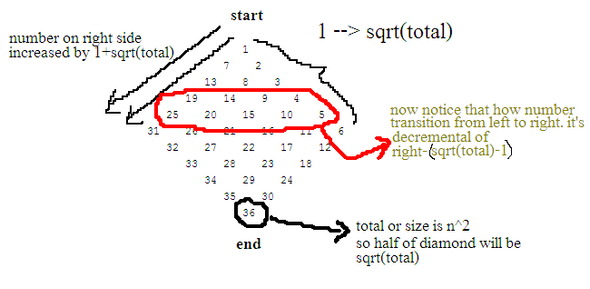today i've encountered a simple yet tricky programming problem which is print a numeric diamond like this.
1
7 2
13 8 3
19 14 9 4
25 20 15 10 5
31 26 21 16 11 6
32 27 22 17 12
33 28 23 18
34 29 24
35 30
36at first glance it's look easy but it's a little bit tricky since the number order is from up to bottom and right to left. it's very different with this kind of numeric diamond
1
2 3
4 5 6
7 8 9 10
11 12 13 14 15
16 17 18 19 20 21
22 23 24 25 26
27 28 29 30
31 32 33
34 35
36so, after analyzing the number sequence i notice that the number order actually work like this diagram
after knowing how the number being ordered, now we can write our program. here's my solution. normally we use 2 times of loop when generating pyramid/diamond which is top and bottom triangle, but in this case we don't need to do that. see how easy to program something when you understand the algorithm.
#include <stdio.h>
#include <math.h>
void diamond(int size) {
int i,j,k,x;
x = sqrt(size);
int left,right=-1*x+1;
for (i = 1; i < x*2 ;i++)
{
left = (i>x)?x*2-i:i;
for (k=0;k<=x-left;k++) printf(" ");
right = (i>x)?right+1:right+x;
printf("%d",right);
for (j = 1;j < left;j++) {
printf(" %d",right-(x-1)*j);
}
printf("\n");
}
}
int main() {
//input must be n^2
diamond(9);
diamond(36);
diamond(100);
diamond(121);
return 0;
}preview numeric diamonds output
if you have any other suggestion in term of better algorithm to solve this, feel free to drop your comment
